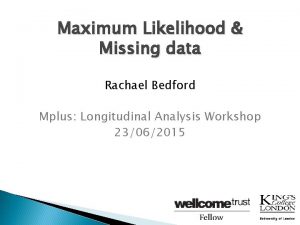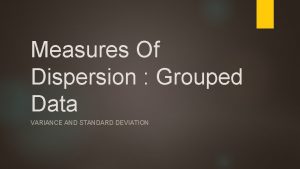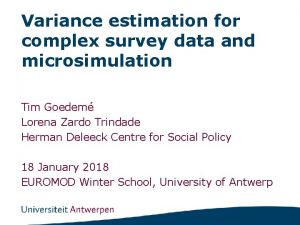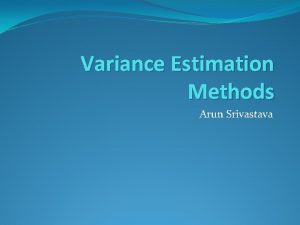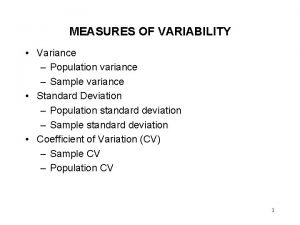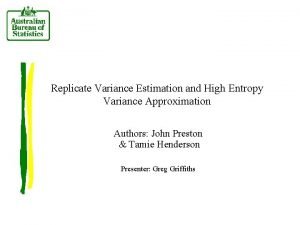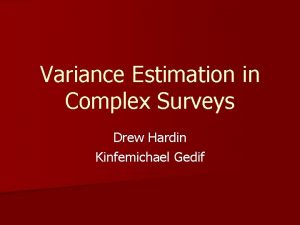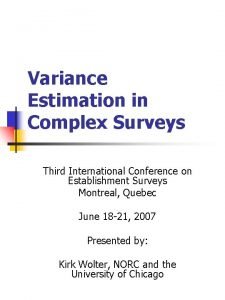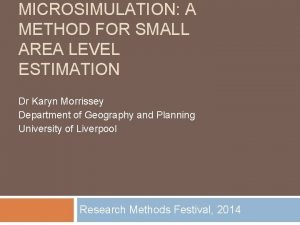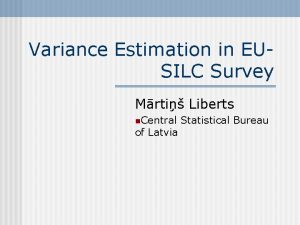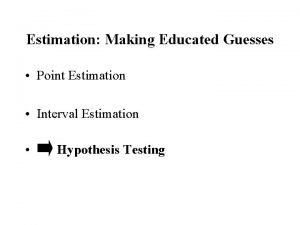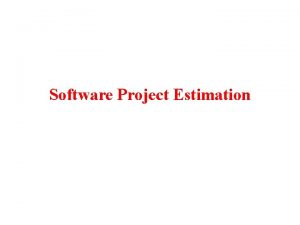Variance estimation for complex survey data and microsimulation













- Slides: 13

Variance estimation for complex survey data and microsimulation Tim Goedemé Lorena Zardo Trindade Herman Deleeck Centre for Social Policy 18 January 2018 EUROMOD Winter School, University of Antwerp

2

3

4

5

6

7

Introduction • Statistics & samples are a powerful tool - Need limited number of observations - Point estimate and estimate of precision However, without an estimate of its precision, a point estimate is pointless… • … at least for evidence-based policy-making 8

Introduction Key messages 1. If estimates are based on samples -> estimate and report SEs, CIs & p-values 2. Always take as much as possible account of sample design when estimating SEs, CIs & p-values 3. Never delete observations from the dataset 4. Never simply compare confidence intervals 9

Introduction Setup of the training • Some concepts and theory • Hands-on exercises, based on synthetic data that reflect real situations in EU-SILC • Focus is on necessities for practical implementation • Targeted to diversified audience (statistical competences, knowledge of statistical software) • Assume some familiarity with analysis of survey data • Complementary to standard courses 10

Introduction Focus on getting variance estimates right Steps in applied survey data analysis Step Activity 1 Definition of the problem & objectives 2 Understanding the sample design 3 Understanding design variables, constructs, and missing data 4 Analysing the data 5 Interpreting and evaluating results 6 Reporting estimates and inferences Source: Heeringa et al. , 2010, p. 9. 11

Introduction DAY 1 1/ Sampling variance and Total survey error 2/ Determinants of the sampling variance 3/ Estimating the sampling variance & EU-SILC sample design 4/ Ultimate cluster approach and EU-SILC sample design variables Exercises DAY 2 5/ subpopulations & comparisons of samples / simulations /… Exercises 6/ Conclusion; feedback 12

Introduction Background materials • Handouts • Do-files & exercises • https: //timgoedeme. com/eu-silc-standard-errors/ (papers, dofiles, csv-files) • https: //timgoedeme. com/course-materials/variance-estimation/ • Heeringa, S. G. , West, B. T. , & Berglund, P. A. (2010). Applied Survey Data Analysis. Boca Raton: Chapman & Hall/CRC. • http: //www. isr. umich. edu/src/smp/asda/ • Groves, R. M. , Fowler, F. J. J. , Couper, M. P. , Lepkowski, J. M. , Singer, E. and Tourangeau, R. (2009), Survey Methodology (Second edition), New Jersey: John Wiley & Sons. 13
 Rsq in standard costing
Rsq in standard costing Pauline and bruno have a big argument
Pauline and bruno have a big argument Droplet infection
Droplet infection Compound complex simple sentences quiz
Compound complex simple sentences quiz Electra complex vs oedipus complex
Electra complex vs oedipus complex Freudian fixation
Freudian fixation Mbti breakdown
Mbti breakdown Abcd of acls
Abcd of acls Multidimensional analysis and descriptive mining of complex
Multidimensional analysis and descriptive mining of complex Eck
Eck Cs 412 introduction to data mining
Cs 412 introduction to data mining Multiple imputation mplus
Multiple imputation mplus Variance of grouped data
Variance of grouped data Mean, median, mode standard deviation for grouped data
Mean, median, mode standard deviation for grouped data











